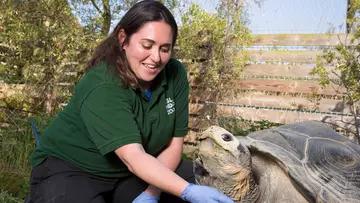
ZSL
Zoological Society of London
ZSL’s Wildlife Health team have carried out the largest ever study into tiger contraception
ZSL’s Wildlife Health team have carried out the largest ever study into tiger contraception and are now ready to share their findings, published recently in the journal Zoo Biology, with the world’s zoo community - supporting vital conservation breeding programmes for threatened tiger species. Lead author, ZSL’s Head of Wildlife Services Dr Amanda Guthrie, explains...

Animals in zoos play a vital part in global conservation breeding programmes, helping us to preserve species that are under threat of extinction for the future. But sometimes, for many reasons, it might not be best for two animals who live together to produce offspring, and in these instances, just like humans, it’s important that animals in zoos are on the right kind of contraception for their health and wellbeing.
But unlike for humans, the amount of data and research into animal birth control has historically been limited, leaving important gaps in our collective knowledge. For example, if the contraception is an implant, has it been placed in the right area for it to work efficiently? Is the dosage correct? There are many micro adjustments that can be made, but only if this kind of information is available – and that takes dedicated research.
Which is why a new ZSL-led study recently published in the journal Zoo Biology is such a huge step forward in the world of veterinary medicine: ‘Contraceptive Use in Tigers’ offers, for the first time, comprehensive and unparalleled guidance to professionals who look after tigers in zoos and animal sanctuaries across the world.
Why are animals in zoos given contraception?
Let’s start with why tigers are sometimes given contraception:
All tigers, from the Endangered Amur tiger in Russia to the Critically Endangered Sumatran in Indonesia, are sadly under threat of extinction from poaching and habitat loss. There are nine subspecies of tiger, three of which are already, sadly extinct. Six remain, including the Sumatran and Amur, and our zoos are part of global collaborative efforts to save them.
As well as working with conservation partners in the field to mitigate issues tigers face in the wild, one important way that zoos are fighting this threat is through conservation breeding programmes – global collaborations between zoos that ensure a healthy and genetically diverse back up population of animals threatened by extinction, in case the worst should happen.

At-risk species, such as tigers, have individual programme coordinators, whose role it is to monitor the population of that species in zoos and pair up the perfect partners to keep the zoo population healthy and sustainable in the long-term.
For example, ZSL manages the European studbook for Sumatran tigers, alongside coordinating the global zoo population of this Critically Endangered species. Tigers may be moved between zoos to be introduced to new mates – London Zoo’s beautiful Sumatran tigress Gaysha arrived from Denmark last December to be introduced to our male, Asim.
But to ensure that individual genetic lines don’t overpopulate the group, and to give zoos time to plan ahead for the growing population, tigers can be placed on contraception at certain points of their life, as recommended by the programme coordinator with the guidance of veterinary professionals.
A breeding programme coordinator’s job can be a tricky one: with the population ever-changing because of births and deaths, the holistic needs of the population changes continually - the use of contraception allows coordinators to better control the health and genetic diversity of the population as a whole.
You might ask why tigers aren’t just housed separately when it’s not the right time for them to breed, instead of being placed on contraception. One answer is that while tigers are not by nature a particularly social feline - unlike lions, for example - sometimes separation may not be in the individual animal’s best interests. In these cases, contraception means they can still have the social interaction that may be needed for their individual wellbeing.
Contraception also gives zoos time to plan for the future care of new individuals, including allowing offspring to remain with each other and their parents for longer before moving to start their own families.

Continually striving for the best: animal welfare research is ever-evolving
ZSL’s Wildlife Health Services team are always looking for new and improved ways to care for our animals, including through using the right kind of contraception, to continually keep animal welfare at the very highest level. We’ve long led the way in wildlife health research, and regularly share findings with the global zoo community.
The new ZSL-led paper is the result of a three-year study to evaluate a relatively new implant, deslorelin acetate (DA), alongside other more historic forms of contraceptives: it’s the first time such an extensive review has been made into tiger contraception and aims to provide animal care professionals with definitive guidance on how to care for the species, in order to ensure that a healthy, genetically diverse population is safe in zoos around the world. Zoo-based tiger health records have been held centrally within the global Association of Zoos and Aquariums (AZA) and the European Association of Zoos and Aquariums (EAZA) since 1989, and it’s this historic collaboration between zoos that has enabled a study of this scale to take place.
As a result, we were able to access records from more than 400 individual female tigers – an incredible dataset for such an elusive and endangered species, which wouldn’t be possible without such a dedicated community of zoo-based conservationists and veterinary professionals.
Findings and next steps
The study found that DA is reassuringly safe, reversible and has less side effects than any other type of tiger contraception available. In the study, we provide clear recommendations and updated guidelines for using it - including for dosage and placement of implants, which can affect their efficacy - so that other zoos around the world can properly use this new form of contraception, when needed, for their tigers.
Our team will use the information gleaned from this important research in our own animal care and focus on proactively sharing the study with our colleagues around the world to support our continued shared goal of a healthy, sustainable population of tiger species in zoos. You can read the full paper here.
